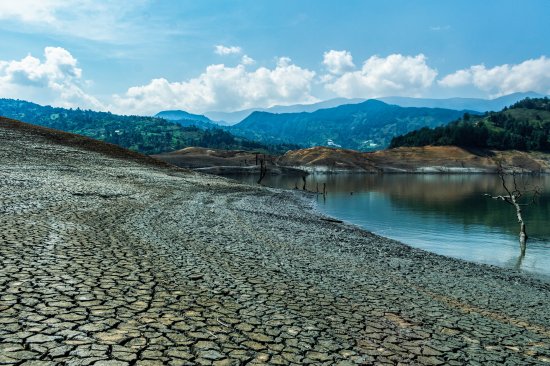
Climate change is contributing to a global drying with no end in sight, according to a new study.
It’s not easy to lose track of Lake Erie. It’s harder still to lose track of two and a half Lake Eries, but that’s more or less what happened back in 2015, when the Earth lost 290 cubic miles (1,200 cubic km) of freshwater, or 250% of Lake Erie’s volume.
The loss of freshwater in lakes, rivers, and underground aquifers was to be expected during the 2014 to 2016 window, since that period coincided with an El Niño warming, during which there is usually more evaporation and less replenishment by precipitation. The problem, as a new paper in Surveys in Geophysics reports, is that eight years later, the lost water has not been replenished—even after the relative cooling of the 2020 to 2023 La Niña cycle.
[time-brightcove not-tgx=”true”]The near-decade of drying coincides with the nine warmest years in the modern climate record, making a strong case that the freshwater loss is a direct result of climate change.
“It’s striking that since 2015 we’ve had a series of years that have all been at the top [in temperature],” says Matthew Rodell, a hydrologist at NASA’s Goddard Space Flight Center, and the lead author of the paper. “It would seem like an incredible coincidence if they’re not related to the water storage decline on land. It’s definitely something to be concerned about.”
The global observations that documented the great drying were conducted by two pairs of spacecraft known as the Gravity Recovery and Climate Experiment, or GRACE, satellites. Jointly operated by NASA, the German Aerospace Center, and the German Research Centre for Geosciences, the original GRACE tandem was launched in 2002 and remained in service until 2017. The second pair, known as the GRACE Follow-On and operated by the same international collaboration, went aloft in 2018 and are expected to function through the end of this decade.
The satellites operate not by directly measuring water levels, but rather by tracking variations in the planet’s gravity field, which change depending on the mass and density of the part of the planet over which each GRACE is flying. “The gravity field is non-uniform,” says Rodell. “Where there’s a mountain range, for example, there’s more mass, which means more gravitational potential, so you’d actually weigh a little bit more when you stand on top of a mountain.”
The same is true of rivers and lakes and aquifers, which exert a slightly more powerful gravitational tug when they’re brimming with water and a slightly less powerful one when they’re less full. The twin GRACEs fly in formation with an average distance of 124 miles (200 km) between them, a gap that widens or narrows slightly when the changing gravitational pull of the planet plucks at them.
“Every five seconds the satellites are measuring the distance with the precision of a micron, which is about the size of a red blood cell,” says Rodell.
Running those gravitational numbers, Rodell and his colleagues arrived at the global loss of 290 cubic miles of freshwater, which, averaged out over all of the world’s lakes, rivers, and underground aquifers, comes out to a drop in water level of 1 cm (0.39 in.). The planet’s total water budget—which includes oceans, seas, clouds, glaciers, polar caps, and more—does not change in times of drought or flood or El Niño or La Niña, of course, and the seemingly missing water is just a tiny fraction of the overall 14 million cubic miles of freshwater the planet holds. But the location of that water matters too, and less and less of it is available to the 8.1 billion humans who depend on it.
Rising global temperatures increase both surface evaporation and the capacity of the atmosphere to hold water vapor, for example, which dries out the soil and aquifers and lowers sea and lake levels. When the super-saturated atmosphere finally does produce rain, it tends to dump it in hard, fast storms, rather than in slower, more drenching downpours that have a better chance of seeping into the dry, compacted surface.
“The extreme precipitation then runs off of the surface and can’t recharge the soil,” says Michael Bosilovich, a senior meteorologist at Goddard and a co-author of the paper. Some of that water drains into fresh lakes and rivers, but more runs into the saltwater ocean. “What we’re not getting is the [freshwater] replenishment we would have had in the past.”
For cities and agricultural regions that rely on aquifers, this can lead to a vicious cycle of drying, with more groundwater being pumped up to meet human needs, less rain falling to replace it, and the rain that does fall draining off. Making things worse has been a series of local, national, and continental droughts that occurred around the world during the period covered by the new study. Intense drying began in northern and central Brazil in 2014, followed by similar conditions in Australia, Southeast Asia, South America, North America, Europe, and Africa. Indeed, 13 of the 30 worst droughts observed by the GRACE satellites since 2002 occurred in 2015 or later, and are believed to have been exacerbated by climate change-related evaporation.
“The series of major droughts around the world explain in large part why we’ve had a persistent decrease in water storage on land,” says Rodell.
At least six more years of readings are expected to be produced by the GRACE Follow-On satellites, and those will tell their own tale of the health of the planet, but the authors of the current study are not optimistic. “At least as far as the GRACE data goes, we don’t see this turning around,” says Bosilovich.
“Going back to the 1980s, there have been equally steep [freshwater] declines, but there has been a recovery afterwards,” says Rodell. “In this one, not only was the drying abrupt and steep, but nine years later, we haven’t recovered.”